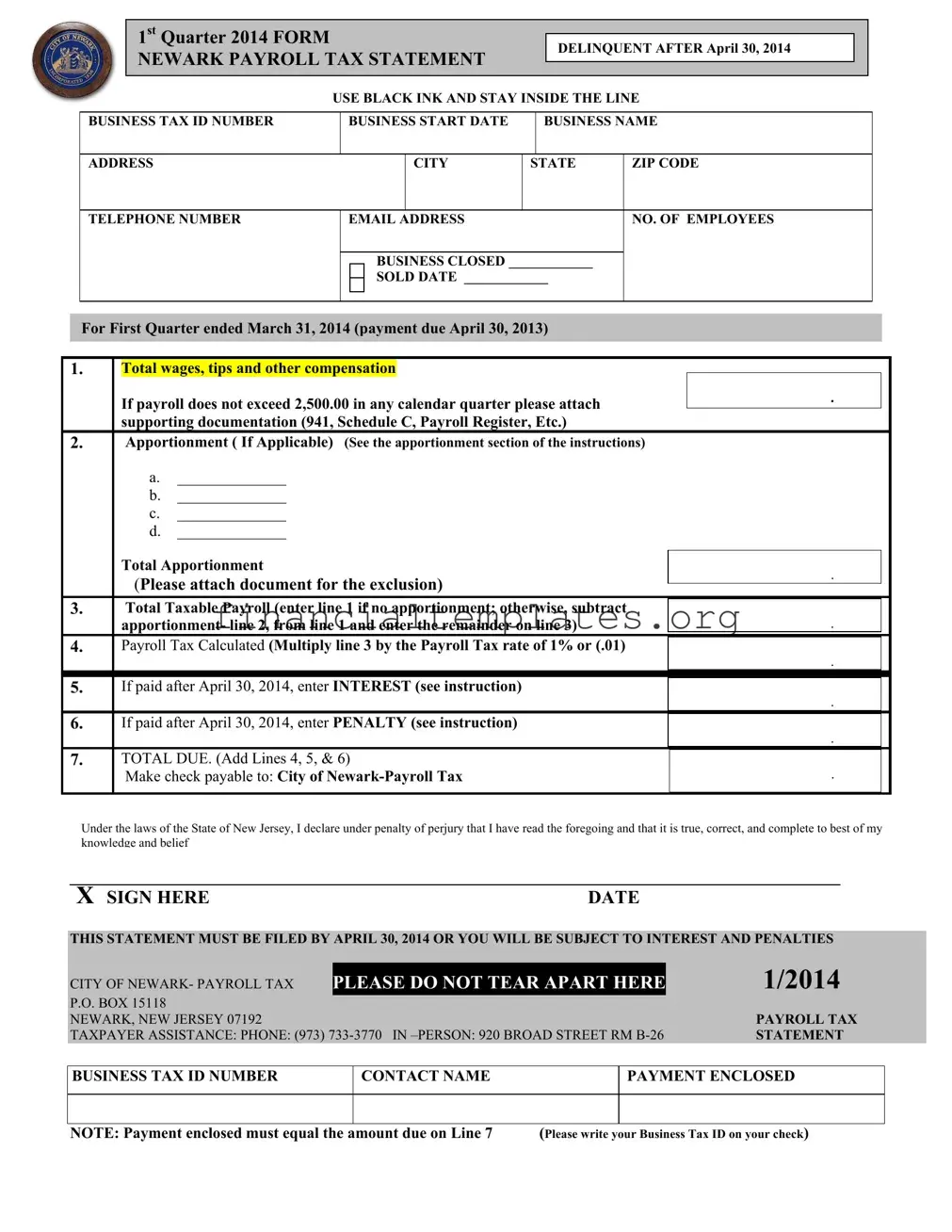The Internal Revenue Service (IRS) Form 941, Employer's Quarterly Federal Tax Return, shares similarities with the Newark Payroll Tax Statement form in that both are used to report wages paid, tips, and other compensation. Form 941 is a federal requirement for employers to report income taxes, Social Security tax, or Medicare tax withheld from employees' paychecks. It also reports the employer's portion of Social Security or Medicare tax. Like the Newark form, it must be filed quarterly and requires identification and business information, making it a fundamental document for payroll reporting at the federal level.
Form W-2, Wage and Tax Statement, is another document that bears resemblance to the Newark Payroll Tax Statement form. The W-2 is used by employers to report the amount of wages paid and taxes withheld for each employee annually. It includes similar information, such as business name, address, and employee compensation. Although the W-2 is an annual requirement and serves a different primary purpose—to provide information to employees for their personal tax returns—it likewise plays a crucial role in reporting compensation and deductions.
The Schedule C (Form 1040), Profit or Loss from Business, is akin to the Newark Payroll Tax Statement form in its relevance to businesses. Specifically utilized by sole proprietors, Schedule C documents the income and expenses of the business, impacting the calculation of taxable payroll. Even though it's more focused on business profitability than payroll taxes per se, the information about compensations and deductions can be intertwined with payroll tax calculations, similar to how businesses must report total wages on the Newark form.
The State Unemployment Tax Act (SUTA) filing that businesses must complete in their respective states parallels the Newark Payroll Tax Statement. While SUTA filings are focused on unemployment tax contributions at the state level, both require information on wages paid to employees. They are periodical (usually quarterly) filings crucial for compliance with state labor and tax laws. The need to detail total wages and taxes calculated makes them similarly essential for payroll administration.
Form W-3, Transmittal of Wage and Tax Statements, works in concert with Form W-2 by summarizing total earnings, tax withholdings, and Social Security and Medicare taxes for all employees of a business. It needs to be filed to the Social Security Administration along with copies of Form W-2. This form parallels the Newark Payroll Tax Statement's role in aggregating payroll data, though the W-3 is focused on annual transmission of employee wage and tax information to federal authorities.
The Form 940, Employer's Annual Federal Unemployment (FUTA) Tax Return, is also similar to the Newark Payroll Tax Statement in its function of reporting on behalf of employees, albeit specifically for unemployment taxes at the federal level. Like the Newark form, it calculates taxes owed based on employee wages but for FUTA rather than local payroll taxes. Both forms are integral in ensuring employers fulfill their tax obligations related to employment.
Payroll Registers, while not an official tax form, are company records that track the detailed wages and deductions for each pay period. This document has a practical resemblance to the Newark Payroll Tax Statement as it serves as a foundational record from which the summary totals on the tax statement are derived. Maintaining an accurate payroll register is essential for completing the Newark form accurately and for internal audits and financial planning.
Form 1099-NEC, Nonemployee Compensation, shares a connection with the Newark Payroll Tax Statement through its role in reporting payments made to non-employee service providers or independent contractors. Although the 1099-NEC is for non-employees and the Newark form is for employees, both are used to report payments that contribute to the total compensation paid by the business. This impacts the total tax reporting and financial assessments within a business context.
The Local Earned Income Tax Return is a document required by many municipalities and localities, similar in purpose to the Newark Payroll Tax Statement. It reports earnings of employees within a specific jurisdiction, highlighting the locality-specific nature of some tax obligations. Though the specific name and requirements may vary by jurisdiction, the underlying purpose aligns closely with Newark's payroll tax statement by focusing on locally earned income and taxes due.
The Business Privilege Tax Return, required in some municipalities, is another form related to the Newark Payroll Tax Statement, as it often considers payroll expenses in the calculation of the tax owed by a business to the local government. However, this form extends beyond payroll to encompass various aspects of business revenue and activity, illustrating the broader scope of business tax liabilities beyond payroll taxes alone. Despite this broader focus, the inclusion of payroll-related data links it to the purpose of the Newark Payroll Tax Statement.

